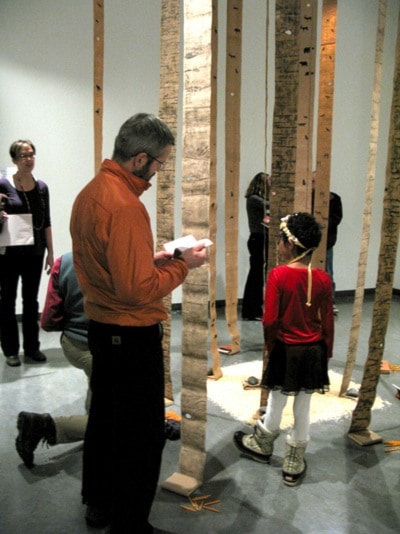The Comox Valley is blessed with an incredibly diverse and rich landscape.
It draws people from near and far to enjoy the beaches, rivers, forests and mountains. Opportunities for recreational, visual and contemplative enjoyment are vast.
We share this landscape with creatures of the land and sea. And unfortunately, our presence often disrupts their habitat, sometimes displacing them from it. By our very love of the land, we shift the balance of nature and impact the region around us.
The Comox Valley Art Gallery will explore this relationship in a three-artist exhibit titled In Place/Displaced. An opening reception in the Contemporary Gallery will take place this Friday from 7 to 9 p.m., and features an artists’ talk at 8.
On Saturday, from 10 a.m. to noon, members from the BCSPCA, Mountainaire Avian Rescue Society, Tsolum River Restoration Society and Project Watershed will participate in a panel discussion focusing on local habitat/conservation, animal rights and wildlife rehabilitation.
“This exhibit is particularly relevant to the Comox Valley,” notes Anh Le, gallery curator. “We broadcast to the world what a great place this is to live yet in order to make room for more people, development displaces the very things that entice people to the area.”
Like most CVAG exhibits, In Place/Displaced explores the ordinary in an extraordinary way.
For instance, Maria Whiteman investigates the ways humans have come to understand and relate to animals. She does this via large-format photographs presented as transparencies. The subject matter is primarily animal specimens found in the University of Alberta’s Museum of Zoology.
“As a visual artist, I’m especially compelled by the ways in which animals are visualized and put on display and how these techniques of representation afford them cultural significance,” Whiteman explains.
In her artist statement, Whitman, who holds a BFA at the University of North Carolina and an MFA at The Pennsylvania State University, writes, “Taxonomia investigates the archive of animal bodies stuffed in jars, held in place by pins, wrapped up in string, and stuffed, mounted and displayed in an effort to render the anarchy of the natural world into the strict categories of science.”
Whitman is a scholar for the Canadian Institute for Research in Computing and the Arts and is the Assistant Professor of Fine Arts, Dept. of Art & Design at the University of Alberta.
Complementing Whiteman’s work are the oil stick and graphite powder drawings on printed rag paper by Pamela Speight. Opportunists – Fauna explores invasive plant species.
“We frequently interact with many organisms that came from elsewhere, especially those that have vigorously established themselves to the obvious detriment of other species,” says the professor of drawing and painting at Vancouver Island University.
“However, a belief that these invaders are entirely ‘bad’ may be somewhat misplaced,” she adds. “After all, we brought them here, either intentionally or unintentionally, on our various migrations across the planet.”
Based in Nanaimo, Speight has completed a BFA at Emily Carr University and an MFA at Ohio State University. Her works are held in many collections including the Burnaby Art Gallery, The Richmond Art Gallery and the Canada Council Art Bank.
“While reviewing submissions from artists the CVAG committee saw that Whiteman and Speight’s presentations had similar themes and thought they would work well together as an exhibit,” says Le. “They focus on humankind's relationships with plants and animals. By adding an installation by Vancouver artist, Haruko Okano, these artworks are tied together with a sense of place.”
Okano was inspired to create All Fall Down when several poplar trees were cut down to widen the road while she was living and working in the Yukon. Using unbleached paper and water-based printing ink, she took rubbings of some of the trees and duplicating these, added silhouettes of animals that inhabited the area.
“I try to close the psychological and physical distance between the art and audience by creating works that include their full sensory experience,” she says. “All Fall Down invites viewers out of their passive positions to literally add to the work or by unconsciously performing within an installation; they become part of the kinesis that animate and bring my work to its’ fullest potential.”
The exhibit includes hand-bound books for people to write their comments or read those of Yukon residents.
Okano was educated at the Doone School of Fine Arts and completed post-grad studies at Central Tech, both in Ontario. She served a two year curatorial apprenticeship at the Grunt Gallery in Vancouver and currently runs the Britannia Art Gallery in the Britannia Library in Vancouver.
Joining the artists for the panel discussion are local residents Jenna Ledingham from the BCSPCA, Maj Birch, founder of Mountainaire Avian Rescue Society, Jack Minard of the Tsolum River Restoration Society and Dan Bowen of Project Watershed.
In Place/Displaced continues at CVAG until March 3. The gallery is open Tuesday through Saturday from 10 a.m. to 5 p.m.
